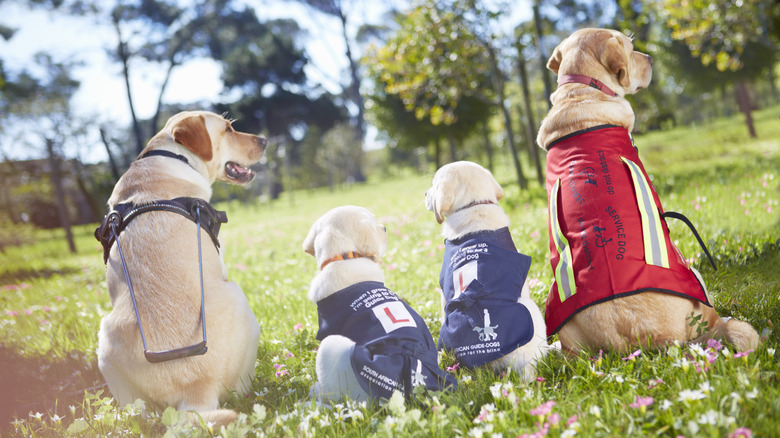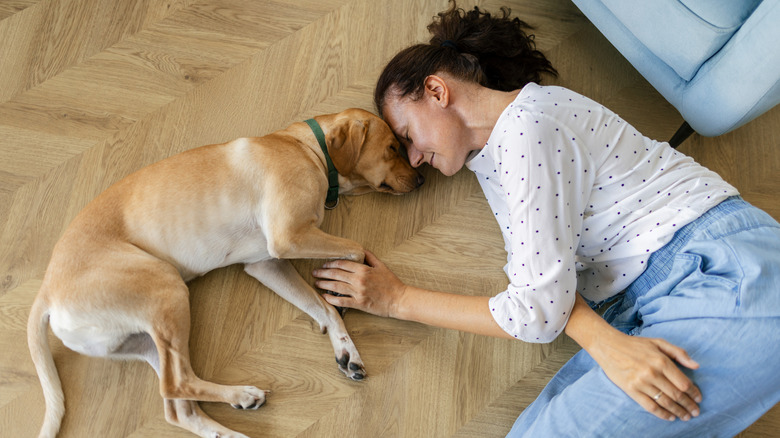How Some Service Dogs Know You're About To Have A Seizure (And What They Do About It)
Service dogs have a long history of helping humans safely navigate the world. Those that can assist their owners with certain physical ailments or health issues are especially valuable, such as seizure-alert dogs (S.A.D.s). These dogs can sense an upcoming seizure before it happens and respond by alerting their owner physically, audibly, or visually without any training. Service dogs may also assist during and after the seizure by performing certain actions to prevent injury and seek additional help.
While every person with epilepsy would prefer if each of their seizures would happen in a completely safe environment, this unfortunately does not always happen. Seizures can happen at any time, day or night, and sometimes at dangerous and inconvenient times and locations. Having a service dog present 24/7 can be helpful for minimizing the risk of injury.
Thanks to the help of service dogs, many lives have been saved and injuries been prevented. However, it's important to note that although only seizure alert dogs can sense an upcoming seizure, all seizure service dogs can play a vital role at different phases of a seizure.
It's believed some dogs can detect a seizure odor in humans
A common misconception about trained service dogs is that all of them can smell and alert their owners to an oncoming seizure. But the truth is most dogs do not have this ability, nor can they actually be trained to predict a seizure. It's believed the dogs that do have the ability to sense an oncoming seizure have it naturally. However, more research is needed to fully comprehend and confirm this phenomenon, as it is based largely on anecdotal evidence from the owners.
In an attempt to better understand the seizure-alerting phenomenon, Queen's University Belfast in Northern Ireland conducted an experiment. The study revealed that every dog in the research group attempted to interact with their owners physically or audibly after detecting a seizure-related odor. None of the dogs were trained to respond this way. The findings suggest a lot about the seizure-detection process, as dogs may be able to smell surprising things that humans can't.
What exactly is a "seizure-related odor"? It's called menthone, the primary component found in seizure-scented sweat that a human gives off before a seizure, per a 2021 study published Epilepsy & Behavior. According to the research, menthone has been identified as a potential human alarm pheromone that may result in changes in a dog's behavior.
How service dogs respond before, during, and after a seizure
Service dogs that assist people with epilepsy are typically seizure-response, seizure-assist dogs, or seizure-alert dogs (SADs). However, all of these canines serve a crucial purpose for epileptics. When a S.A.D. senses a seizure coming, they might bark anxiously, whine, pace near their owner, and/or get close to their face and stare at them. This alerting behavior can take place a few seconds or more than 45 minutes before the seizure occurs, allowing the owner to move to a safe location and be prepared.
As the names imply, seizure-response and seizure-assist dogs are trained to respond after the seizure has already begun. These dogs learn to assist by lying down near the owner or barking to seek help from someone. They can also be trained to retrieve medication from a specific location. A S.A.D. can be trained to perform these same tasks, making them a vital companion to an epileptic.
Seizure-response and seizure-assist service dogs can use their sense of smell to determine that someone is having a seizure in a similar way that S.A.D.s do. The human body produces certain odor chemicals during a seizure that dogs can smell. Dr. Craig Angle, the co-director of the Canine Performance Sciences Program at Auburn University, told Scientific American that a dog can detect this scent in a person's breath, sweat, and urine.
Interested in learning more about these remarkable canines? Take a look at how service dogs are ushering in a new era of domestication.


